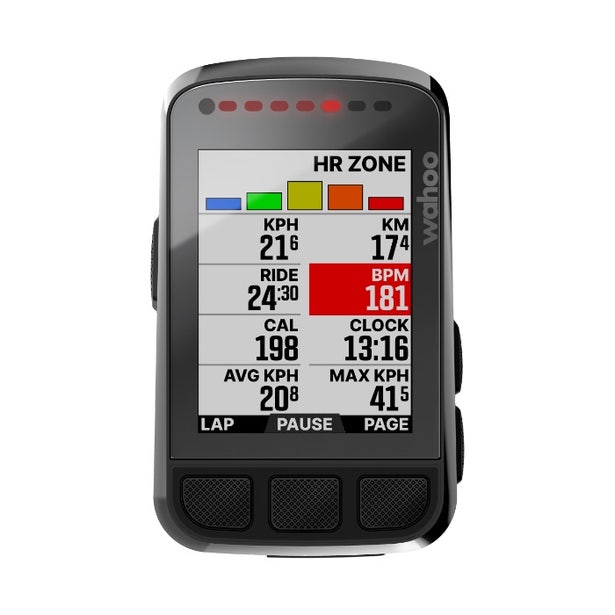
wahoo ELEMNT BOLT V2 GPS CYCLING COMPUTER
incl. FREE shipping & free returns

Von Lukas Vogt |
4 minutes read time

Now that you know what VO2Max is and how you can increase it through targeted training , the next important question is: How do you measure your VO2Max and check your progress? There are various methods that can help you determine your maximum oxygen uptake - from professional laboratory tests to estimates from fitness equipment or apps. In this article, I'll show you the best ways to measure your VO2Max and what you should keep in mind when doing so.
If you want an accurate measurement of your VO2Max, a lab test is the gold standard. In such a test, you cycle on an ergometer or treadmill until you are completely exhausted while your breath is analyzed. The test measures the oxygen and carbon dioxide levels in your breath to determine exactly how much oxygen your body can use during maximum exertion.
Advantages of laboratory measurement:
Disadvantages:
A convenient and inexpensive alternative to laboratory measurements are fitness trackers, apps or racing bike computers that estimate your VO2Max. These devices use algorithms to calculate an approximate VO2Max based on data such as heart rate, speed, distance covered and power.
Many modern road bike computers (such as the Garmin Edge or Wahoo ELEMNT) offer this function. They use heart rate data in conjunction with your performance on the bike to estimate your VO2Max. Some smartwatches and apps such as Strava or TrainingPeaks also offer this function.
Advantages of estimation by devices:
Disadvantages:
Road bike computers like the Garmin Edge 1030 or the Wahoo ELEMNT ROAM now offer an impressive range of features to analyze your performance - including VO2Max estimation. These devices calculate your VO2Max based on your power data (watts) and heart rate values. But how accurate are these measurements really?
The accuracy depends heavily on the quality of the heart rate measurement and the reliability of the power data. If you use a chest strap (instead of the optical measurement on the wrist), you will usually get more accurate values. Power measurement (for example via a power meter) is also important, as the algorithms relate the heart rate to the power delivered to estimate your VO2Max.
Tip: If you want to measure your VO2Max regularly using a road bike computer, you should always create similar conditions. Make sure you are well rested and try to take the measurements under comparable weather conditions and on similar terrain.
| method | Advantages | Disadvantages |
|---|---|---|
| laboratory measurement | Very precise, comprehensive data | Expensive, time-consuming, not suitable for regular measurements |
| road bike computers/apps | Simple, cost-effective, regular measurements possible | Less accurate, dependent on algorithms and external factors |
| smartwatches | Convenient, available at any time | Heart rate measurement on the wrist less precise |
For most road cyclists, the VO2Max estimate from fitness equipment or apps is completely sufficient. However, if you need very precise data - for example, when starting out in professional sport - or want a very precise picture of your current performance, a laboratory measurement is recommended.
How often you should measure your VO2Max depends on your training goal and your current level of performance. For most riders, an estimate every few weeks or months is enough to track progress. However, if you are preparing for a race or specifically want to increase your VO2Max, a weekly check may be useful.
Realistic progress: It is important to have realistic expectations. VO2Max can be increased through training, but the progress is often not huge. For beginners or those returning to cycling, improvements of 10-20% are possible in the first few months. Advanced riders tend to see smaller increases of 2-5% per year, as VO2Max cannot be increased indefinitely.
Measuring VO2Max is a great way to track your progress as a cyclist and work specifically on your performance. While a laboratory measurement is the most accurate method, modern road bike computers and apps offer practical and inexpensive alternatives that are more than sufficient for most riders.
Choose the method that best suits your goals and budget, and keep an eye on your VO2Max to ensure your training is bearing fruit and you're reaching your full potential on the road bike!

Als Rennradfahrer möchte man möglichst ständig besser werden: schneller, ausdauernder und effizienter. Doch was, wenn der Schlüssel zu diesen Zielen nicht nur auf zwei Rädern liegt? Rudern, oft unterschätzt, bietet eine ideale Ergänzung zum Radtraining. Es trainiert nicht nur den ganzen Körper, sondern verbessert auch die Ausdauer, Kraft und Stabilität – entscheidende Faktoren für jeden Radsportler.

Nach einer intensiven Rennrad-Einheit ist die richtige Regeneration entscheidend, um Leistung zu verbessern, Verletzungen zu vermeiden und langfristig Fortschritte zu erzielen. Doch wie sieht eine effektive Erholung aus? Hier bekommst Du die besten Tipps zur optimalen Regeneration nach dem Rennradtraining.

Erfahre, wie Radsport-Ligen aufgebaut sind und weitere Infos zur Organisation im Profi-Radsport!